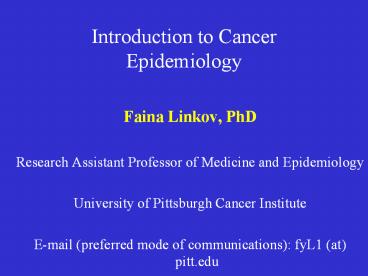Introduction to Cancer Epidemiology - PowerPoint PPT Presentation
Title:
Introduction to Cancer Epidemiology
Description:
University of Pittsburgh Graduate School of Public Health, one of the oldest ... Immunologic Factors. Cancer disparities. Inherited Susceptibility (Polymorphisms) ... – PowerPoint PPT presentation
Number of Views:59
Avg rating:3.0/5.0
Title: Introduction to Cancer Epidemiology
1
Introduction to Cancer Epidemiology
- Faina Linkov, PhD
- Research Assistant Professor of Medicine and
Epidemiology - University of Pittsburgh Cancer Institute
- E-mail (preferred mode of communications) fyL1
(at) pitt.edu
2
University of Pittsburgh Graduate School of
Public Health, one of the oldest school to
advocate for chronic disease epidemiology research
3
What this course is about
- Learning more about cancer epidemiology
- Investigating risk factors implicated in cancer
development - Learning to write grants and critique articles
- Learning to be passionate about chronic disease
epidemiology
4
True or False?
- Smoking causes lung cancer
5
True or False?
- Large percentage of cancers are preventable
6
True or False?
- In the past 20 years tremendous improvements in
the treatment of all cancers have been achieved
7
True or False?
- Preventing cancer is easier than treating cancer
8
True or False?
- Screening tests are available for most cancers
9
Epidemiology
- Distribution and determinants of disease
frequency in human populations
10
Cancer EpidemiologyHistorical Perspective
- 1775
- British surgeon, Percival Pott reported probably
the first description of occupational
carcinogenesis in the form of scrotum cancer
among chimney sweeps.
11
Cancer EpidemiologyHistorical Perspective
- Tight corsets and cancer
- 1842
- Rigoni-Stern, Italian physician, observed that
married women in the city were getting cervical
cancer, but nuns in nearby convents werent. He
also observed that nuns had higher rates of
breast cancer, and suggested that the nuns
corsets were too tight.
12
Five Criteria for a Cause ? Effect Relationship
Criteria Risk Factor for Disease
1) Timing Exposure occurs before development of disease or during its progression
2) Strength Is dose-dependent Cessation of exposure can modify disease
3) Prevalence Occurs in multiple populations
4) Relationship to other risk factors Is independent Can also act synergistically
5) Plausibility Produces structural or functional changes which are events in mechanism of disease
anatomic or molecular
13
Cancer EpidemiologyHistorical Perspective
- 1700s tobacco and cancer
- Reports of cancer risks associated with tobacco
in the 18th century included snuff taking and
nasal cancer, reported by Hill in 1761, and pipe
smoking and lip cancer by von Soemmering in 1795.
14
Cancer EpidemiologyHistorical Perspective
- Tobacco and Lung Cancer
- Asbestos and Lung Cancer
- Leather Industry and Nasal Cancer
- Dyes and Bladder Cancer
- Ionizing Radiation and Many Cancers
- DES and Vaginal Adenocarcinoma
- EBV and Burkitts Lymphoma
- HPV and Cervical Cancer
15
Cancer EpidemiologyAn Introduction
- The Epidemiologic Perspective
- Aims of Cancer Epidemiology
- Methods of Epidemiology
- Historical Perspective and Examples
- Contemporary Studies
- The Future
16
Aims of Cancer Epidemiology
- Uncover new etiologic leads
- study of the distribution of cancer
- quantify the risk associated with different
exposures and host factors - Promote insights into the mechanisms of
carcinogenesis - Assess efficacy of preventive measures
- Investigate predictors of survival
17
Types of Epidemiologic Studies
- Cohort
- Case-Control
- Cross-Sectional (Prevalence)
- Other
18
Methods of Cancer Epidemiology
- Descriptive Studies
- Incidence, mortality, survival
- Time Trends
- Geographic Patterns
- Patterns by Age, Gender, SES, Ethnicity
- Analytic Studies
- Case-control
- Cohort
19
Challenges to Interpretation
- Observational vs. Experimental Design
- Cancer clusters
- Study Design and Conduct
- Study Size
- Biases Misclassification, confounding,
selection - Exposure assessment important
- Epidemiology and strong and weak effects
- Impact on a population level
- Replication critical
20
Cancer EpidemiologySources
- US SEER Registry System
- IARC International Registries
- State/Hospital Registries
- Etiologic Clues
- Alert Clinician
- Experimental Studies
21
(No Transcript)
22
Cancer EpidemiologyCurrent/Future Topics
- Infectious Agents
- Cancer and inflammation
- Obesity
- Physical Activity
- Diet
- Hormones
- Immunologic Factors
- Cancer disparities
- Inherited Susceptibility (Polymorphisms)
23
Cancer EpidemiologyCurrent/Future Topics
- Tumor (somatic) Alterations
- Cancer Classification
- Biomarkers of Exposure/Effect
- Vaccines
- Survivorship
- Cancer and disability
- Alternative therapy































